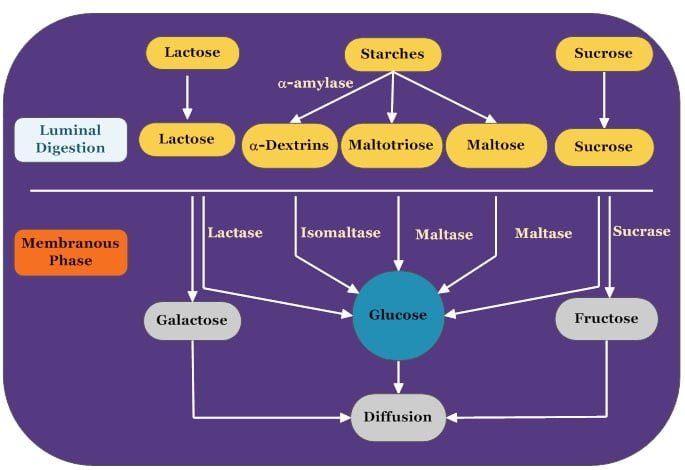TABLE OF CONTENTS
Chemical digestion of nutrients
Chemical digestion of each major nutrient is by hydrolysis glycosidic bonds in carbohydrates, peptide bonds in proteins, ester bonds in fats and phophodiester bonds in nucleic acids by the insertion of water molecule.
Hydrolysis of nutrients in the digestive tract is catalysed by the action of enzymes secreted by salivary, gastric and pancreas glands. These glands pour their enzymes in the lumen of the GI tact for mixing with ingesta hence referred to as luminal phase of digestion. This phase of digestion results in incomplete hydrolysis of nutrients leads to the production of short-chain polymers of original macromolecule.
In the membranous phase of digestion, the enzymes are synthesised within the enterocytes and transported to the apical membrane. Direct contact of these enzymes in the epithelium with the substrates derived from luminal phase of digestion exhibit final break down of the products of the short-chain polymers of luminal phase of digestion into monomers inside the epithelium of small intestine, hence referred to as membranous phase of digestion. It is followed by the absorption of end products of nutrients across the intestinal epithelium.
Carbohydrate digestion
Dietary carbohydrates are mainly monosaccharides (Glucose, galactose and fructose) disaccharides (lactose and sucrose) and fibrous carbohydrates (cellulose, hemicellulose).
Oligosaccarides (maltose, isomaltose and maltotriose are rarely present in the diet, but they are formed in the gut during the course of carbohydrate digestion.
Starches is present as amylose and amylopectin.
Amylose contains glucose monomers linked by a -1, 4 glyosidic linkage, whereas amylopectin also contain glucose linked by a -1, 4 glyosidic linkage, but the chains are branched, having a -1, 6 glyosidic linkage at branched points.
- Enzymatic digestion of nutrients takes place in two phases
- Luminal phase
- Membranous phase
Luminal phase of enzymatic digestion
In luminal phase of digestion, alpha amylase is secreted by the salivary glands (eg. pig, dog and rabbit), and pancreatic amylase hydrolyses starches to yield oligosaccharides (a -dextrins, maltotriose, maltose without free glucose),whereas fibrous carbohydrates (eg. Cellulose and hemicellulose) can not be hydrolyzed by alpha amylase of mammals.
Hydrolysis of amylopectin produces branched-chain oligosaccharides, limit dextrin and alpha 1, 6-linked disaccharide, isomaltose.
Membranous phase of digestion
The oligosaccharides, di- and tri-saccharides are hydrolyzed by saccharidase enzymes like maltase, isomaltase, sucrase and lactase in the membranous phase.
In the glycocalyx of enterocytes, these enzymes hydrolyze the oligosaccharides (eg. maltose, sucrose and lactose) to monosaccharides (glucose, galactose, and fructose).

Most of the monosaccharides are absorbed into the portal blood and carried to liver. some are also absorbed through lymph stream.